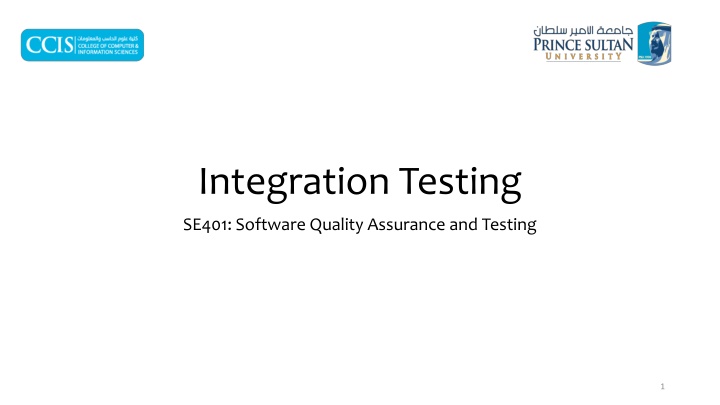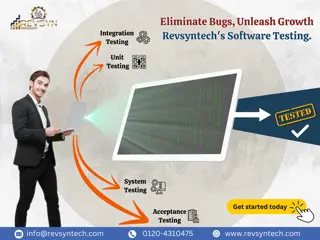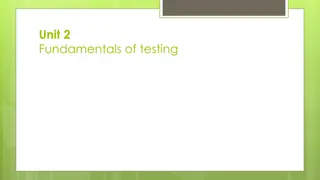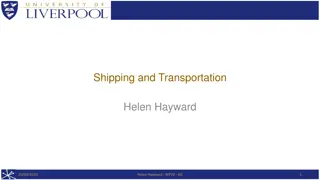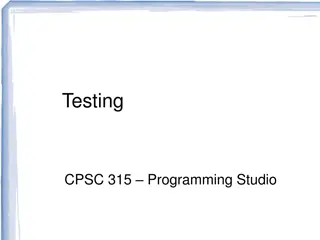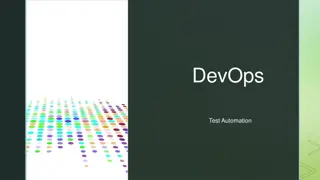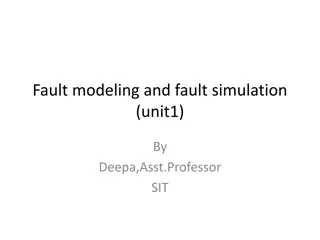Integration Testing
Integration testing plays a critical role in software quality assurance by combining and testing individual software modules as a group to ensure seamless operation. This phase follows unit testing and precedes validation testing. By understanding the objectives and strategies of integration testing, software teams can prevent critical failures like the case of the Mars Climate Orbiter.
Download Presentation

Please find below an Image/Link to download the presentation.
The content on the website is provided AS IS for your information and personal use only. It may not be sold, licensed, or shared on other websites without obtaining consent from the author.If you encounter any issues during the download, it is possible that the publisher has removed the file from their server.
You are allowed to download the files provided on this website for personal or commercial use, subject to the condition that they are used lawfully. All files are the property of their respective owners.
The content on the website is provided AS IS for your information and personal use only. It may not be sold, licensed, or shared on other websites without obtaining consent from the author.
E N D
Presentation Transcript
Integration Testing SE401: Software Quality Assurance and Testing 1
Outline Case Study - Mars Climate Orbiter Integration Testing Integration Test Strategies System, Acceptance, and Regression Testing Acceptance Testing System Testing Regression Testing Summary 2
Case Study Mars Climate Orbiter 3
Case Study Mars Climate Orbiter NASA s Mars Climate Orbiter Launched on December 11, 1998 Intended to enter an orbit at 140 150 km above Mars. On September 23, 1999 It smashed into the planet's atmosphere and was destroyed. Cost: $328M 4
Case Study Mars Climate Orbiter Cause of failure The software controlling the thrusters on the spacecraft used different units. Software modules were developed by teams in US and Europe Engineers failed to convert the measure of rocket thrusts English unit: Pound-Force Metric unit: Newton, kg m / s2 Difference: a factor of 4.45 5
Integration Testing Integration testing (sometimes called integration and testing, abbreviated I&T) is the phase in software testing in which individual software modules are combined and tested as a group. It occurs after unit testing and before validation testing. 6
Objectives Understand the purpose of integration testing Distinguish typical integration faults from faults that should be eliminated in unit testing Understand the nature of integration faults and how to prevent as well as detect them Understand strategies for ordering construction and testing Approaches to incremental assembly and testing to reduce effort and control risk 7
Integration vs. Unit Testing Unit (module) testing is a necessary foundation Unit level has maximum controllability and visibility Integration testing can never compensate for inadequate unit testing Integration testing may serve as a process check If module faults are revealed in integration testing, they signal inadequate unit testing If integration faults occur in interfaces between correctly implemented modules, the errors can be traced to module breakdown and interface specifications 8
Integration Testing The entire system is viewed as a collection of subsystems (sets of classes) determined during the system and object design Goal: Test all interfaces between subsystems and the interaction of subsystems The Integration testing strategy determines the order in which the subsystems are selected for testing and integration. 9
Why do we do integration testing? Unit tests only test the unit in isolation Many failures result from faults in the interaction of subsystems Often many Off-the-shelf components are used that cannot be unit tested Without integration testing the system test will be very time consuming Failures that are not discovered in integration testing will be discovered after the system is deployed and can be very expensive. 10
Types of Testing Unit Testing: Individual subsystem Carried out by developers (of components) Goal: Confirm that subsystems is correctly coded and carries out the intended functionality Integration Testing: Groups of subsystems (collection of classes) and eventually the entire system Carried out by developers Goal: Test the interface and the interplay among the subsystems 11
Types of Testing System Testing: The entire system Carried out by developers (testers!) Goal: Determine if the system meets the requirements (functional and global) Functional Testing: Test of functional requirements Performance Testing: Test of non-functional requirements Acceptance and Installation Testing: Evaluates the system delivered by developers Carried out by the client. Goal: Demonstrate that the system meets customer requirements and is ready to use 12
What is Integration Testing? Unit/module test Integration test System test Specification: Module interface Interface specs, module breakdown Requirements specification Visible structure: Coding details Modular structure (software architecture) none Scaffolding required: Some Often extensive Some Looking for faults in: Modules Interactions, compatibility System functionality 13
Testing Level Assumptions and Objectives Unit Assumptions Unit Goals All other units are correct Correct unit function Compiles correctly Coverage metrics satisfied Integration Assumptions Integration Goals Interfaces correct Correct function across units Fault isolation support Unit testing complete System Assumptions System Goals Integration testing complete Correct system functions Tests occur at port boundary Non-functional requirements tested Customer satisfaction 14
What is Software Integration Testing? Testing activities that integrate software components together to form a complete system. To perform a cost-effective software integration, integration test strategy, integration test set are needed. Integration testing focuses on: Interfaces between modules (or components) Integrated functional features Interacting protocols and messages System architectures Who performs software integration: Developers and test engineers What do you need?: Integration strategy Integration test environment and test suite Module (or component) specifications Interface and design documents 15
Integration Faults Inconsistent interpretation of parameters or values Example: Mixed units (Pound/Newton) in Martian Lander Violations of value domains, capacity, or size limits Example: Buffer overflow Side effects on parameters or resources Example: Conflict on (unspecified) temporary file 16
Integration Faults Omitted or misunderstood functionality Example: Inconsistent interpretation of web requests Nonfunctional properties Example: Unanticipated performance issues Dynamic mismatches Example: Incompatible polymorphic method calls 17
Example: A Memory Leak Apache web server, version 2.0.48 Response to normal page request on secure (https) port static void ssl_io_filter_disable(ap filter t *f) { bio_filter_in_ctx_t *inctx = f->ctx; inctx->ssl = NULL; inctx->filter_ctx->pssl = NULL; } No obvious error, but Apache leaked memory slowly (in normal use) or quickly (if exploited for a DOS attack) 18
Example: A Memory Leak Apache web server, version 2.0.48 Response to normal page request on secure (https) port static void ssl_io_filter_disable(ap filter t *f) { bio_filter_in_ctx_t *inctx = f->ctx; SSL_free(inctx -> ssl); inctx->ssl = NULL; inctx->filter_ctx->pssl = NULL; } The missing code is for a structure defined and created elsewhere, accessed through an opaque pointer. 19
Example: A Memory Leak Apache web server, version 2.0.48 Response to normal page request on secure (https) port static void ssl_io_filter_disable(ap filter t *f) { bio_filter_in_ctx_t *inctx = f->ctx; SSL_free(inctx -> ssl); inctx->ssl = NULL; inctx->filter_ctx->pssl = NULL; } Almost impossible to find with unit testing. (Inspection and some dynamic techniques could have found it.) 20
What is a software integration strategy? Software test strategy provides the basic strategy and guidelines to test engineers to perform software testing activities in a rational way. Software integration strategy usually refers to an integration sequence (or order) to integrate different parts (or components) together 21
Maybe Youve Heard ... Yes, I implemented module A, but I didn t test it thoroughly yet. It will be tested along with module Bwhen that s ready. 23
Translation ... Yes, I implemented module A, but I didn t test it thoroughly yet. It will be tested along with module Bwhen that s ready. I didn t think at all about the strategy for testing. I didn t design module A for testability and I didn t think about the best order to build and test modules A and B 24
Integration Plan & Test Plan Integration test plan drives and is driven by the project build plan A key feature of the system architecture and project plan ... ... Build Plan Test Plan ... System Architecture 25
Drivers and Stubs Driver: A program that calls the interface procedures of the module being tested and reports the results A driver simulates a module that calls the module currently being tested Stub: A program that has the same interface as a module that is being used by the module being tested, but is simpler. A stub simulates a module called by the module currently being tested 26
Drivers and Stubs Module Under Test Driver Stub procedure call procedure call access to global variables Driver and Stub should have the same interface as the modules they replace Driver and Stub should be simpler than the modules they replace 27
Stubs and drivers Driver: A component, that calls the TestedUnit Controls the test cases Driver Tested Unit Stub: A component, the TestedUnit depends on Partial implementation Returns fake values. Stub 28
Example: A 3-Layer-Design (Spreadsheet) A Spread A Spread SheetView SheetView A Layer I B B Entity C C D D Data Model Model Currency Converter Converter Currency Layer II B Calculator C Calculator D E E G G F F Layer III BinaryFile Storage Storage BinaryFile Currency DataBase DataBase Currency XMLFile Storage Storage XMLFile E G F 29
Approaches to Integration Testing ( source of test cases) Functional Decomposition (most commonly described in the literature) Top-down Bottom-up Sandwich Bigbang Call graph Pairwise integration Neighborhood integration 30
Basis of Integration Testing Strategies Functional Decomposition applies best to procedural code Call Graph applies to both procedural and object-oriented code 31
ExampleCalendar Program Date in the form mm, dd, yyyy Calendar functions the date of the next day (NextDate) the day of the week corresponding to the date the zodiac sign of the date the most recent year in which Memorial Day was celebrated on May 27 the most recent Friday the Thirteenth 32
Calendar Program Units Main Calendar FunctionisLeap ProcedureweekDay ProceduregetDate FunctionisValidDate Function lastDayOfMonth Procedure getDigits ProcedurememorialDay FunctionisMonday Procedure friday13th FunctionisFriday ProcedurenextDate ProceduredayNumToDate Procedure zodiac 33
Functional Decomposition of Calendar Calendar (Main) isLeap weekDay getDate zodiac nextDate Friday13th MemorialDay isValidDate getDigits isMonday DaynumToDate isFriday lastDayOfMonth dateToDaynum 34
First Step in Top-Down Integration Calendar (Main) isLeap weekDay getDate zodiac nextDate Friday13th MemorialDay Grey units are stubs that return the correct values when referenced. This level checks the main program logic. 35
weekDayStub Procedure weekDayStub(mm, dd, yyyy,dayName) If ((mm = 10)AND (dd = 28)AND (yyyy = 2013)) Then dayName = Monday EndIf . . . If ((mm = 10)AND (dd = 30)AND (yyyy = 2013)) Then dayName = Wednesday EndIf 36
Next Three Steps (replace one stub at a time with the actual code.) Calendar (Main) isLeap weekDay getDate zodiac nextDate Friday13th MemorialDay Calendar (Main) isLeap weekDay getDate zodiac nextDate Friday13th MemorialDay Calendar (Main) isLeap weekDay getDate zodiac nextDate Friday13th MemorialDay 37
Top-Down Integration Mechanism Breadth-first traversal of the functional decomposition tree. First step: Check main program logic, with all called units replaced by stubs that always return correct values. Move down one level replace one stub at a time with actual code. any fault must be in the newly integrated unit 38
Bottom-Up Integration Mechanism Reverse of top-down integration Start at leaves of the functional decomposition tree. Driver units... call next level unit serve as a small test bed drive the unit with inputs drivers know expected outputs As with top-down integration, one driver unit at a time is replaced with actual code. Any fault is (most likely) in the newly integrated code. 39
Top-Down and Bottom-Up Integration Both depend on throwaway code. drivers are usually more complex than stubs Both test just the interface between two units at a time. In Bottom-Up integration, a driver might simply reuse unit level tests for the lower unit. Fan-in and fan-out in the decomposition tree results in some redundancy. 40
Starting Point of Bottom-Up Integration Calendar (Main) isLeap weekDay getDate zodiac nextDate Friday13th MemorialDay isValidDate getDigits isMonday isFriday DaynumToDate lastDayOfMonth dateToDaynum 41
Bottom-Up Integration of Zodiac Calendar (driver) isLeap weekDay getDate zodiac nextDate Friday13th MemorialDay 42
Sandwich Integration Avoids some of the repetition on both top-down and bottom-up integration. Nicely understood as a depth-first traversal of the functional decomposition tree. A sandwich is one path from the root to a leaf of the functional decomposition tree. Avoids stub and driver development. More complex fault isolation. 43
A Sample Sandwich Calendar (Main) isLeap weekDay getDate zodiac nextDate Friday13th MemorialDay isValidDate getDigits isMonday DaynumToDate isFriday lastDayOfMonth dateToDaynum 44
Big Bang Integration Calendar (Main) isLeap weekDay getDate zodiac nextDate Friday13th MemorialDay isValidDate getDigits isMonday DaynumToDate isFriday lastDayOfMonth dateToDaynum 45
Big Bang Integration No... stubs drivers strategy And very difficult fault isolation This is the practice in an agile environment with a daily run of the project to that point. 46
Top-down Approach Vs Bottom-up Approach Basis for Comparison Top-down Approach Bottom-up Approach Basic Breaks the massive problem into smaller sub- problems Solves the fundamental low-level problem and integrates them into a larger one Process Submodules are solitarily analyzed Examine what data is to be encapsulated, and implies the concept of information hiding Redundancy Contain redundant information Redundancy can be eliminated Programming languages Structure/procedural oriented programming languages Object-oriented programming languages Mainly used in Module documentation, test case creation, code implementation and debugging Testing 47
Pros and Cons of Decomposition-Based Integration Pros intuitively clear build with proven components fault isolation varies with the number of units being integrated Cons based on lexicographic inclusion (a purely structural consideration) some branches in a functional decomposition may not correspond with actual interfaces. stub and driver development can be extensive 48
Call Graph-Based Integration Definition: The Call Graph of a program is a directed graph in which nodes are unit edges correspond to actual program calls (or messages) Call Graph Integration avoids the possibility of impossible edges in decomposition- based integration. Can still use the notions of stubs and drivers. Can still traverse the Call Graph in a top-down or bottom-up strategy. 49
Call Graph of the Calendar Program Calendar (Main) getDate zodiac nextDate memorialDay weekDay Friday13th getDigits dateToDaynum dayNumToDate isMonday isFriday isValidDate lastDayOfMonth isLeap 50
